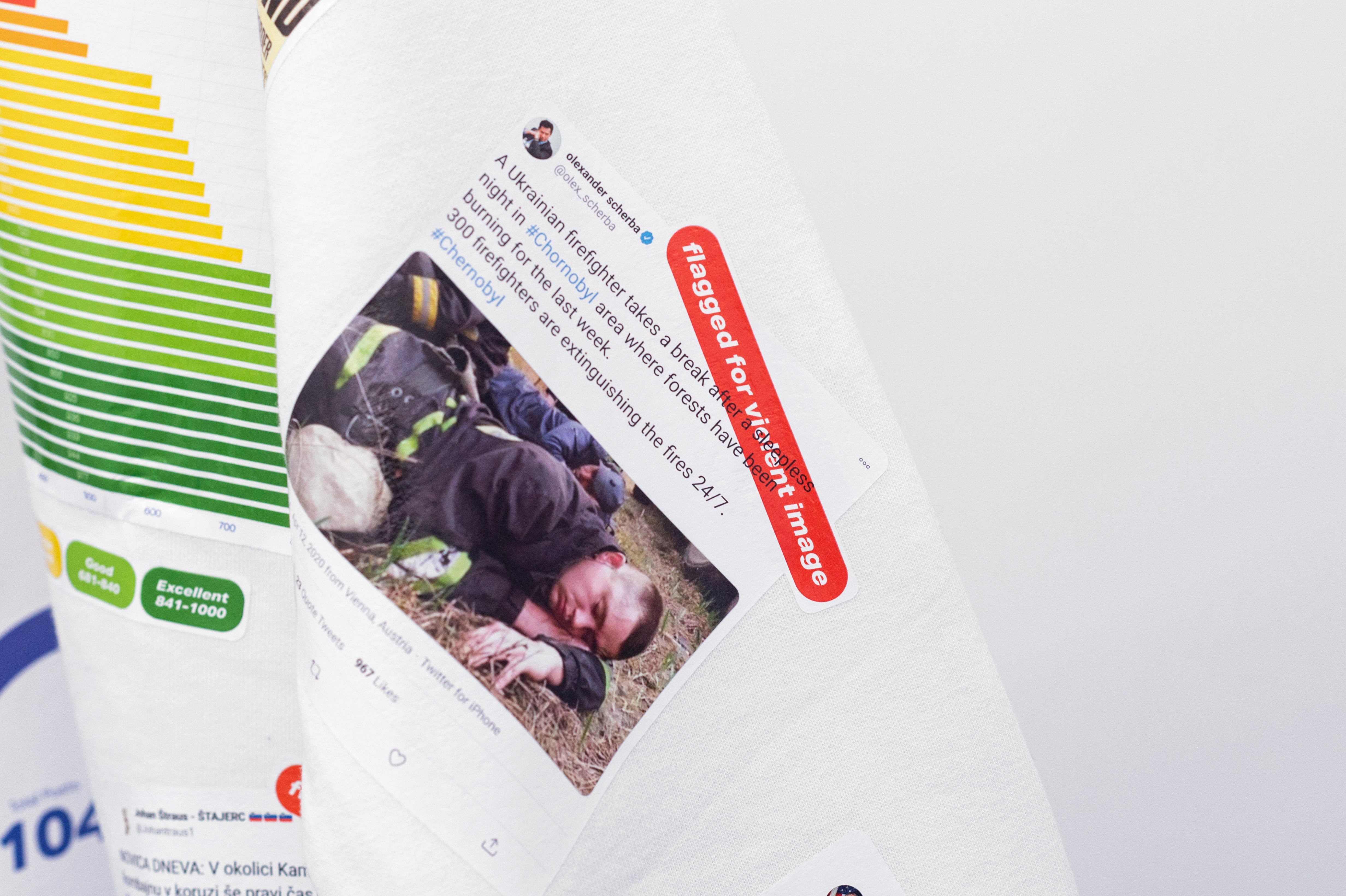"Flagged for", 2020
May 2022
Ingrid Luquet-Gad

detail, !Mediengruppe Bitnik, "Flagged for Political Speech", 2021
May 2022
Ingrid Luquet-Gad
Flagged for lulz
!Mediengruppe Bitnik might just be doing it for the lulz. To present-day eyes and ears, this internet phrase is already an item of media folklore. Referring to a carnivalesque laughter rising from the depth of message boards, the term denotes both a specific historic context and a strategic positioning towards institutional power. The former has become understood through anthropologic studies of the hacker galaxy Anonymous Chronicled by scholar Gabriella Coleman in her eponymous study published a decade ago, Hacker, Hoaxer, Whistleblower, Spy: The Many Faces of Anonymous., and it also marks a global, generational awareness of internet-assisted activism. The latter, meanwhile, is a spirit and a strategy, symbolised through the persona of the lone trickster, jester or fool, which transcends mediatic regimes – one that, plunging its roots in the avant-garde practices of Dadaist outrage and Ubu-esque absurdity, resurfaces in sweeping waves at times of paradigmatic political change.
These two strands of analysis – the temporal and the transhistorical – are what make a reflection on !Mediengruppe Bitnik’s practice all the more compelling. Without any additional context, the first impression of their recent “Flagged for” series (2020–ongoing) is one of seamless contemporaneity. A visualisation of the automated enactment of censorship according to a set of predefined criteria, the works’ surfaces are covered entirely with various “flagged” social media posts. The project’s first iteration, Flagged for Political Speech (2020), takes the form of 27 white sweatshirts, each of which is printed with flagged posts from and qualitative analyses of each European Union state leader’s social media presence. Hung from the ceiling, the installation confronts the viewer with a range of portraits not unlike Dadaist caricatural collages made from newspapers: a series of “bachelor machines Marcel Duchamp first used the term “bachelor machine”, or machine célibataire, in a preparatory note written for his work The Large Glass (1915–23) and as a pendant to the “bride machine” on the upper part of the glass-pane. Composed of a various separate machinic or diagrammatic elements, it alludes to the rapid industrialisation of society and its subsequent transformation of the human. To Gilles Deleuze and Félix Guattari, it represents of the alliance of desiring machines and the body without organs.” at the advanced stages of reification, where an auto-generated recombination of publicly available data becomes a stand-in for the subject’s long-lost unity.
A second layer of meaning makes the work more complex. Here, the analysis of a person’s data trail, although automated, also implies a commodification of how it’s carried out and by whom. As the developers and marketers of the algorithms, several commercial companies sell their services to potential employers, banks and insurances companies as well as to states’ border police forces and citizenship caseworkers. While the criteria used by the algorithms remain hidden, their effects spill over from the digital to the physical, further cementing asymmetries in access, visibility and mobility. The second piece in the series, Flagged for Explicit Image (2021), turns a closer lens to the personal consequences of assessing an individual according to a fixed set of norms and binaries: Your post is either flagged or not; your presence deemed negative or not. Through a made-to-order bomber jacket (size S–XL) or wallpaper (adapted to the site and size of the wall), any person – no longer only a political official or a blue-check figure – can wear their score on their sleeve or cover their domestic space with their metrics. To phrase it after Hito Steyerl, herself indebted to the mimetic excess that runs from Dada to hacker: “We successfully impersonate a human for a machine,” so why not “intensify it” and make it visible to all?
With the “Flagged for” series, !Mediengruppe Bitnik’s deriding laughter conveys two slightly different qualities of lulz. Flagged for Political Speech builds on the established tradition of the struggle of the powerless against the powerful that became especially visible around the turn of the 2010s, when leaderless, networked protest movements expanded earlier phreaker and hacker solitary modes of action to the 99%. In keeping with this tradition, the work proceeds to invert, even if incidentally so, the given polarities of social order. With the exhibition context acting as a carnivalesque space and time, updating the medieval celebration that performed a collective upending of hierarchies, we too can watch the watchers, prey on the predators and feel temporarily liberated from established public symbols of political power – theirs a relative one compared to a greater evil, the immaterial and infallible authority. Although similar in appearance, Flagged for Explicit Image could seem closer attuned to the helpless jolt, barely a laugh, more of an anxious smirk, of the post-internet years and the end of that decade. As the target grows individualised, turning from deriding governments and supra-national entities into mimicking ordinary systems of oppression, mechanisms of control seem to tighten on the span of actions afforded to every social actor.
What is reflected in !Mediengruppe Bitnik’s series corresponds to a wider societal shift, tapping into aesthetic nihilism as that which remains when action feels structurally paralysed. It can, however, be helpful here to dive deeper into the duo’s practice and to look at its continuity through time, so as to assess whether these recent works constitute a continuation by other means, or a paradigmatic break, with the artists’ earlier pieces. Carmen Weisskopft and Domagoj Smoljo first met when they were students at the University of Zurich in 2000. Two years later, they decided to create their first website and to do so surreptitiously swapped one of the university’s servers for their own. Connecting it to the internet, they named the hidden bug in the academic matrix “bitnik” – a rephrasing, like lulz is to lol, of the beatniks who refused conventional society at the turn of the 1950s. If their collaboration originated as an act of trolling, then their first projects similarly stayed true to the popular hacker slogan, “Do not propose, do!” With Opera Calling! (2007), which transmitted opera concerts for free to randomly dialled landlines in Zurich, or ‘CCTV Dérives’ (2009–10), a series undertaken in various cities that used self-made signal receivers to disclose hidden surveillance-camera signals in public spaces, !Mediengruppe Bitnik enacted a strategy of reversed surveillance, watching the watchers by tapping into existing networks and repurposing their uses.
Delivery for Mr. Assange (2013), arguably their best-known work, proceeded similarly while simultaneously anchoring the viewing experience more directly in the exhibition context. Here, a parcel containing a camera and a GPS signal was sent to Julian Assange, the founder of WikiLeaks, who was living in reclusion at the Ecuadorian Embassy in London. Via a hole in the cardboard package, the camera recorded the parcel’s 32 hours in transit, from the 16th to the 17th of January 2013, through the Royal Mail postal system as it was en route to its hyper-surveyed addressee. A livestream of the journey, transmitted to the duo’s website and Twitter account in real time, was then presented in 2014 at the Helmhaus Zurich as a video installation alongside a life-size recreation of the hacktivist’s room at the embassy. The same year, Random Darknet Shopper (2014–16) went on to put the artistic institution directly to the test, this time using its space for the intervention itself. With a budget of $100 in Bitcoin per week, a bot was programmed to randomly buy items on the illicit goods emporium Agora. The items were shipped to the exhibition space, Kunst Halle Sankt Gallen, unpacked as they arrived and mounted for display. Upon charges (later dropped) of buying ecstasy, the Swiss authorities closed the exhibition.
When looking at the mischief-making collective’s practice over a wider span of time, there are overarching tones and actions that continue to inform their most recent pieces – even if they resort to more conventional modes of display. What remains is the earlier spirit of politicised laughter – a lulz putting pressure on any system and apparatus – of the early 2000s. Beyond the apolitical stance of post-internet art and its present day metastases, !Mediengruppe Bitnik’s approach persists even if their visual language evolves and adapts. In a way, their strategy could also be approached according to what design collective Metahaven explored in their 2013 book Can Jokes Bring Down Governments?: They defined the joke as an “open source weapon of the public”, one with the “capacity to resist and overturn the frame of reference imposed by any political status quo”. In their “Flagged for” pieces, the duo’s oppositional stance may be less frontal, but the present-day era is one where the lines between inside and outside, private and public, aesthetics and politics, have become more blurred – and the mimicry ever closer to its subject.

Ingrid Luquet-Gad is an art critic based in Paris and a doctoral candidate at Université Paris 1 Panthéon-Sorbonne. She is the arts editor of Les Inrockuptibles, a contributing editor to Spike Art Magazine, and a correspondent for Flash Art. Her research, developed through essays, catalogue texts and conferences, explores the individual and collective structures of the networked self and investigates strategies of artistic autonomy developed in the 2010s.